|
|
|
Sort Order |
|
|
|
Items / Page
|
|
|
|
|
|
|
| Srl | Item |
| 1 |
ID:
133289
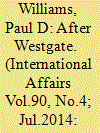

|
|
|
|
|
| Publication |
2014.
|
| Summary/Abstract |
The attack on the Westgate Mall in Nairobi, Kenya, in September 2013 intensified international scrutiny of the war against Harakat Al-Shabaab Mujahideen (Movement of the Warrior Youth). This article analyses the current state of affairs with reference to the three principal sets of actors in this war: Al-Shabaab, the African Union Mission in Somalia (AMISOM) and its international partners, and the various actors currently involved in building the Somali Federal Government's security forces. It argues that although the newly reconfigured Al-Shabaab poses a major tactical threat in Somalia and across the wider Horn of Africa, the movement is becoming a less important actor in Somalia's national politics. As Al-Shabaab loses territory and its popularity among Somalis continues to dwindle, other clan- and region-based actors will become more salient as national debates over federalism, the decentralization of governance mechanisms beyond Mogadishu and the place of clannism will occupy centre stage. As a consequence, AMISOM's principal roles should gradually shift from degrading Al-Shabaab towards a broader stabilization agenda: encouraging a national consensus over how to build effective governance structures; developing an effective set of Somali National Security Forces; and ensuring that the Federal Government delivers services and effective governance to its citizens, especially beyond Mogadishu in the settlements recently captured from Al-Shabaab. As it stands, however, AMISOM is not prepared to carry out these activities. More worryingly, nor is the Somali Federal Government.
|
|
|
|
|
|
|
|
|
|
|
|
|
|
|
|
| 2 |
ID:
154988
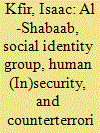

|
|
|
|
|
| Summary/Abstract |
This article examines the link between human security, social identity, and al-Shabaab. The first section explores how social identity group theory can help explain al-Shabaab's recruitment. The second part focuses on the counterterrorism campaign against al-Shabaab, which involves decapitation, aggressive peacekeeping through a proxy in the shape of the African Union Mission in Somalia, and the role of a domestic de-radicalization program. The article concludes that al-Shabaab's allure is in decline and the group is facing internal turmoil, which makes its overtures toward the Islamic State of Iraq and the Levant very dangerous, as al-Shabaab could act as an effective conduit between the Arabian Peninsula and Africa.
|
|
|
|
|
|
|
|
|
|
|
|
|
|
|
|
| 3 |
ID:
180657
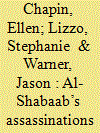

|
|
|
|
|
| Summary/Abstract |
In the study of terrorism, assassinations and suicide bombings have most commonly been considered as distinct phenomena. In practice, however, Al-Shabaab has shown a proclivity to use suicide bombings precisely as a means of assassination. But just how unique – if at all – is its use of suicide bombing assassinations (SBAs)? Using three unique databases on African suicide bombing combined with data from the Global Terrorism Database, this article seeks to understand the degree of uniqueness of Al-Shabaab’s SBA efforts from 2006 to 2020. In comparing Al-Shabaab to its nearest analogues – Boko Haram and Al-Qaeda in the Islamic Maghreb (AQIM) – across five different SBA metrics, this article demonstrates how Al-Shabaab is indeed rightly considered to be unique in its tendency to use suicide bombings as a tool for assassinations, at least on the African continent. It concludes by considering just what rationales underlie this proclivity, focusing on group-specific and environmental factors.
|
|
|
|
|
|
|
|
|
|
|
|
|
|
|
|
| 4 |
ID:
144184
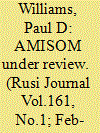

|
|
|
|
|
| Summary/Abstract |
Since mid-2013 AMISOM has undergone a series of strategic reviews aimed at strengthening the mission, and since early 2014 it has conducted four major operations aimed at taking the fight to Al-Shabaab. Although these operations have enjoyed some successes, AMISOM continued to confront four major challenges that badly hindered its ability to achieve its mandated tasks. Paul D Williams explores these challenges – both internal and external to AMISOM – and argues that AMISOM cannot be expected to implement a successful exit strategy unless these issues are addressed.
|
|
|
|
|
|
|
|
|
|
|
|
|
|
|
|
| 5 |
ID:
173837
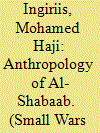

|
|
|
|
|
| Summary/Abstract |
Harakaat Al-Shabaab Al-Mujaahiduun (henceforth Al-Shabaab) is an active insurgent group in southern Somalia battling against the foreign forces and foreign-backed Somali forces. Despite recruiting both in Somalia and in the diaspora, this insurgency movement continues to increasingly recruit more local Somali youth than diaspora Somalis or non-Somalis. This article suggests that Al-Shabaab solicits support from diverse youth who – due to a confluence of factors – join the insurgency movement in various ways. The article reveals how the movement’s methods are flexible insofar as it skilfully recruits both powerful clans and marginalised clans. This pattern tests the limits of the Somali federal government in Mogadishu who have yet to develop innovative approaches to challenge and contain Al-Shabaab. The government failure not only allows Al-Shabaab to successfully carry out its operations but also to sustain itself in the midst of local communities. Through interviews with former Al-Shabaab youth, the article explores youth recruiting efforts and finds that the militant movement pursues various sophisticated means to lure numerous youth into its ranks.
|
|
|
|
|
|
|
|
|
|
|
|
|
|
|
|
| 6 |
ID:
188031
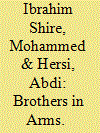

|
|
|
|
|
| Summary/Abstract |
Globally, the spread and use of suicide bombing attacks have become a regular occurrence. Suicide terrorism literature focuses primarily on conventional suicide bombing attacks. However, a growing trend has been observed in the adoption of complex suicide attacks. Using Al-Shabaab as a case study, this paper investigates the phenomenon of complex suicide attacks. We explore the tactical differences of complex suicide attacks vis-à-vis simple attacks in terms of its target goal, discriminative lethality, and delivery method. The paper relies on a uniquely constructed dataset of the group’s suicide operations, employing a variety of data collection techniques. The findings reveal that, inter alia, complex suicide attacks reduce civilian casualties compared to simple suicide attacks. Contrary to the group’s intent and official guidelines to target foreign entities; findings illustrate that domestic targets bear the brunt of most complex suicide attacks. These findings have the potential to contribute to counter-terrorism strategies and be adopted by concerned states in order to effectively protect significant loss of lives and destruction of property resulting from suicide terrorism.
|
|
|
|
|
|
|
|
|
|
|
|
|
|
|
|
| 7 |
ID:
160733
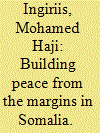

|
|
|
|
|
| Summary/Abstract |
The prevailing discourse in Mogadishu among the federal government of Somalia and the international community is that Al-Shabaab is no longer relevant in contemporary Somali political landscape. In the language of the government, Al-Shabaab is like a lost crocodile thrown out from the river. In the lexicon of the international community, Al-Shabaab is gradually receding. In fact, Al-Shabaab is actually puissant and potent in terms of social, political and military capabilities; not just in Somalia, but also in the wider East Africa region. Why is Al-Shabaab resilient and resistant? Why is it even more effective than the federal government? To answer these questions, this article reveals how Al-Shabaab is increasingly more legitimate than the federal government. In conclusion, the article proposes that negotiated settlement with the insurgency movement could lead to peace in war-torn southern Somalia.
|
|
|
|
|
|
|
|
|
|
|
|
|
|
|
|
| 8 |
ID:
168855
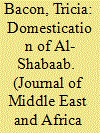

|
|
|
|
|
| Summary/Abstract |
How much influence did foreign fighters exert over al-Shabaab’s insurgency in Somalia? An emerging policy consensus is that foreign fighters exert decisive influence on insurgencies, even affecting conflict duration, intensity, and outcomes. Nevertheless this study argues that foreign combatants in Somalia have exerted a more limited influence than this consensus suggests, though this influence has varied over time. Foreign fighters were present within al-Shabaab from its inception, and remain a part of the group over ten years later. Over this period, non-Somali combatants enjoyed the most influence during the insurgency against Ethiopian forces between 2007 and 2008, when al-Shabaab was a young organization facing a superior enemy. Over time, foreign fighters’ influence within the insurgency in Somalia diminished as al-Shabaab became “domesticated,” i.e. gained controlled of territory and began to govern. This study examines four periods in recent Somali history: the Islamic Court Union’s rise pre-2006, the Ethiopian invasion from 2007 to 2008, al-Shabaab’s territorial conquests from 2009 to 2010, and the internal divisions and purge from 2011 to 2013. This article concludes with a word of caution on the growing perceptions that foreign fighters shape insurgencies and that their involvement significantly helps or hurts local opposition movements. In the case of al-Shabaab’s insurgency in Somalia, transnational insurgents shaped external actors’ calculus in ways that have affected the conflict’s duration, intensity, and even outcomes, but they did not have a commensurate impact within the insurgency.
|
|
|
|
|
|
|
|
|
|
|
|
|
|
|
|
| 9 |
ID:
129606


|
|
|
| 10 |
ID:
180658
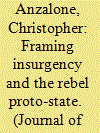

|
|
|
|
|
| Summary/Abstract |
This article traces the foundations, development, and evolution of Al-Shabaab’s multi-tiered media and information operations through a historical lens from proto and early Al-Shabaab media in 2006 and early 2007 up to the beginning of 2021. Arguing that the group’s media campaign is an integral part of its broader proto-state governance operations and kinetic actions, the article pays particular attention to central narrative frames aimed at domestic Somali, regional East African, and international audiences – both friendly and non-friendly – as well as to the role of media and information operations as part of the group’s domestic governance operations.
|
|
|
|
|
|
|
|
|
|
|
|
|
|
|
|
| 11 |
ID:
163699
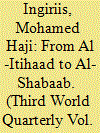

|
|
|
|
|
| Summary/Abstract |
External intervention has frustrated and continues to frustrate peace and stability in the Horn of Africa and Somalia, adding various adverse layers to an already complicated and complex conflict. The level of forceful military engagement intended for regional domination has profoundly affected negatively the efforts of peacebuilding and statebuilding in Somalia. This article examines how the earlier Ethiopian policies towards Somalia has reshaped the (post)-Cold War politics of the Horn. In doing so, it traces the roots of the Ethiopian intervention in Somalia vis-à-vis new non-state armed groups to chart the changing political dynamics of the conflict in Somalia. By using historical approach, the article argues that Ethiopia’s agenda is central to understanding why the ‘War on Terror’ has strengthened and subsequently midwifed armed militant movements (e.g. new insurgency groups) in Somalia, starting from Al-Itihaad to today’s Al-Shabaab. In focusing upon various regional actors and groups, the article moves from the emphasis of internal systems to external power structures, considering the wider historical and political factors in the region that must be closely examined if the regional and local conflicts are to be deeply understood. While it is a context-specific study, the article aims to contribute fresh perspectives and insights to ongoing discussions on the consequences of the Ethiopian intervention in Somalia.
|
|
|
|
|
|
|
|
|
|
|
|
|
|
|
|
| 12 |
ID:
181751


|
|
|
|
|
| Summary/Abstract |
This paper examines the funding sources of the terrorist group Harakat al-Shabaab al-Mujahideen. Using existing research and original interviews, this study outlines al-Shabaab’s history and funding sources. It theorizes that an organization’s capacity to operate in different fields of economic activity drives innovation in funding. Applying a framework for terrorist innovation to al-Shabaab’s funding sources, this study finds support for the theory. Development of intelligence and taxation capabilities is especially prevalent in the al-Shabaab context. Holding territory considerably increases organizational ability to raise funds. Increasing reliance on criminality may compromise an organization’s ideological character and leave it more vulnerable to inter-group competition.
|
|
|
|
|
|
|
|
|
|
|
|
|
|
|
|
| 13 |
ID:
173192
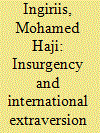

|
|
|
|
|
| Summary/Abstract |
This article examines the various deficiencies of the security agency of the Federal Government of Somalia in Mogadishu in terms of intelligence capacity, capability and competence to counter Harakaat Al-Shabaab Al-Mujaahiduun (hereafter Al-Shabaab), the militant movement fighting against the government and its external backers. Based on field-based oral and written research data in Mogadishu, the article argues that the heavy dependence of the government's National Intelligence and Security Agency (NISA) on various external patrons essentially makes the agency less efficient and effective than Al-Shabaab's intelligence agency, the Amniyat. Looking at the internal dynamics of the government and its rival insurgency movement offers fresh anthropological insights into how the Amniyat is more dynamic than the government's intelligence agency. In spite of its internal faults and failures, the Federal Government has become stuck in an externally-imposed security architecture envisioned by the so-called ‘partners’. This has made the NISA far behind the Amniyat in terms of security provision because both opposing security agencies pursue different methods to broadcast their power and presence. Delving deeper into the inner workings of the security institutions of the NISA and the Amniyat demonstrates that the performances and practices of the two intelligence agencies reflect the acute failure that inherently characterises the government security sector.
|
|
|
|
|
|
|
|
|
|
|
|
|
|
|
|
| 14 |
ID:
159209
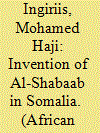

|
|
|
|
|
| Summary/Abstract |
Despite the growing body of academic literature that seeks to explain the evolution of Al-Shabaab, the movement remains one of the least understood on the continent. This article explores the relationship between the militant movement and the twentieth-century anti-colonial Somali insurgency movement of the Dervishes, examining the extent to which Al-Shabaab imitates the Dervishes. It argues that Al-Shabaab is not unique when considered as a contemporary re-incarnation of the Dervishes. Approaching Al-Shabaab as a heterogeneous insurgency movement established and sustained by emulation, the article compares Al-Shabaab to the Dervishes in terms of their leadership characteristics, war strategies and ideological foundations. In doing so, it uses interviews and focus group discussions carried out in Mogadishu and Afgooye (Somalia) as well as a variety of under-explored sources such as visual data. It concludes that Al-Shabaab draws directly and indirectly from the Dervishes in crucial ways, but that there are also differences between the two movements in terms of mobilization and utilizing political and cultural dynamics.
|
|
|
|
|
|
|
|
|
|
|
|
|
|
|
|
| 15 |
ID:
137753
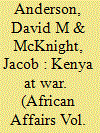

|
|
|
|
|
| Summary/Abstract |
Kenya’s invasion of southern Somalia, which began in October 2011, has turned into an occupation of attrition – while “blowback” from the invasion has consolidated in a series of deadly Al-Shabaab attacks within Kenya. This article reviews the background to the invasion, Operation Linda Nchi, and the prosecution of the war by Kenya’s Defence Forces up to the capture of the city of Kismayo and the contest to control its lucrative port. The second section discusses Al-Shabaab’s response, showing how the movement has reinvented itself to take the struggle into Kenya. We conclude that while the military defeat of Al-Shabaab in southern Somalia seems inevitable, such a victory may become irrelevant to Kenya’s ability to make a political settlement with its Somali and wider Muslim communities at home.
|
|
|
|
|
|
|
|
|
|
|
|
|
|
|
|
| 16 |
ID:
137204
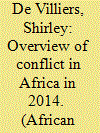

|
|
|
|
|
| Summary/Abstract |
Violent conflict escalated in Africa in 2014, with five sub-Saharan states – the Central African Republic (CAR), Nigeria, Somalia, South Sudan and Sudan – accounting for an estimated 75% of all conflict-related deaths on the continent. This paper provides an overview of the five major sub-Saharan African conflicts in 2014 and considers the underlying causes and dynamics in the Seleka/anti-Balaka conflict in the CAR, the Islamist threats of Boko Haram and al-Shabaab in Nigeria and Somalia, the civil war in South Sudan, and the long-running conflict between Sudan's government and southern and Darfuri rebels. The paper unpacks the general trends evident in these conflicts and the implications for the settlement thereof, including the targeting of civilians, ethnic and religious mobilisation and the state as epicentre of violence. The paper concludes with a brief look ahead to 2015.
|
|
|
|
|
|
|
|
|
|
|
|
|
|
|
|
| 17 |
ID:
191055
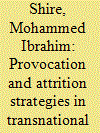

|
|
|
|
|
| Summary/Abstract |
Scholars have identified a range of terrorist strategies that militant groups employ to influence intended audiences, but there is scant empirical validation. Following Kenya’s invasion of Somalia in late 2011, Al-Shabaab executed retaliatory terrorist attacks in Kenya with the strategic aim to compel the withdrawal of Kenyan troops from Somalia. Drawing on unique in-depth interviews with Al-Shabaab defectors and civilian witnesses to counterterrorism measures in Kenya, this article investigates the strategic motives underlying Al-Shabaab’s transnational terrorist operations and assesses the effect these have had on the intended audiences. The empirical findings reveal that the attrition strategy has underpinned Al-Shabaab’s major terrorist attacks (large-scale events) whilst their minor terrorist attacks (small-scale events) have been motivated by the provocation strategy, aimed at eliciting a repressive state overreaction against Kenya’s Somali and Muslim minorities. Whilst the major terrorist attacks succeeded in fomenting the Kenyan public’s anti-war views, this did not result in troop withdrawal; the minor terrorist attacks, however, engendered harsh state repression and draconian measures against Kenya’s Somali and Muslim minorities, ultimately exacerbating existing grievances and channelling fresh recruits to Al-Shabaab. This article contributes to the growing literature on terrorist strategies, offering nuanced empirical insights to understanding the strategic motives underpinning transnational terrorist campaigns. The article demonstrates that transnational terrorism campaigns are rooted in the strategic need to influence different audiences abroad. Depending on militant groups’ short- and long-term objectives, the type of attack indicates the type of terrorist strategy they will employ.
|
|
|
|
|
|
|
|
|
|
|
|
|
|
|
|
| 18 |
ID:
147722
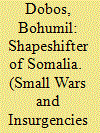

|
|
|
|
|
| Summary/Abstract |
The article presents the application of a concept of political territoriality in the case of Al-Shabaab. It first presents territoriality as a human strategy based on control of territory. Hereinafter, the set of criteria for the examination of political territoriality is presented. It concludes that given the development of Al-Shabaab, we can identify three distinct periods connected to the ′organization’s relation to territory: 2006–2008 – defiance; 2009–2011 – supremacy; and 2012–present – withdrawal. The issue of the deterritorialization of Al-Shabaab since 2012 is also connected to the need to enhance the strategies used against the group as it is becoming more connected to population and functional identification than territory.
|
|
|
|
|
|
|
|
|
|
|
|
|
|
|
|
| 19 |
ID:
182865


|
|
|
|
|
| Summary/Abstract |
Some Somali majority clan girls and women receive economic and security benefits from marriage to Al-Shabaab fighters. Yet, the literature treats women’s experiences monolithically and misses the role that race plays in determining the circumstances of such unions. The authors argue that one should not refer to the unions of Somali Bantu girls and women with Al-Shabaab fighters as a “marriage” but rather as sexual and domestic slavery – a form of extraction by Al-Shabaab that works to ethnically cleanse the Bantu from their ancestral land. Drawing on data from an original survey conducted in 2017 of 139 Somali Bantu refugee households who fled to Kenya during the previous year, the authors examine the nature and extent of unions between females from different races with Al-Shabaab fighters. Women and girls from majority clans are more likely to marry fighters freely. Compared to majority clan females, Somali Bantu girls are enslaved by Al-Shabaab fighters at younger ages and typically remain with their own families rather than moving to the man’s household, contrary to Somali’s patrilineal marriage customs. Al-Shabaab fighters do not claim the children they have with Somali Bantu girls and women, whom they despise as a racially distinct minority with low social status. This work underscores the need to avoid the term “marriage” when referring to the sexual slavery of minorities in Somalia by Al-Shabaab and for the international community both to investigate claims of ethnic cleansing as well as support the fledgling Somali government in establishing a system of rule of law.
|
|
|
|
|
|
|
|
|
|
|
|
|
|
|
|
| 20 |
ID:
148246
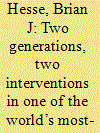

|
|
|
|
|
| Summary/Abstract |
In 1992, more than 25,000 United States forces landed in Somalia as part of a 37,000-strong United Nations Task Force (UNITAF) operation. In 2011, a combined total of 8000+ Kenyan and Ethiopian forces were ordered into Somalia. This article demonstrates that American soldiers were deployed to Somalia in the early days of a post-Cold War world, largely as a foreign policy experiment about how to deal with the threats ‘small states’ posed in a new world order. It is maintained that Kenyan and Ethiopian soldiers were deployed to Somalia to deal with some of the very threats American foreign policymakers had identified almost two decades earlier, from refugees to terrorism. To conclude, the article uses public goods theory to contend that military interventions that are ostensibly peacekeeping in nature can be inherently inadequate because ‘self-interest works against the interests of the collective’ (Bobrow and Boyer, 1997: 726). Accordingly, America’s intervention in Somalia between 1992 and 1994 failed to remedy adequately the circumstances and concerns which spawned the perceived need for Kenyan and Ethiopian forces to intervene in Somalia a generation later, in 2011. Unfortunately for Kenyan and Ethiopian soldiers, Somalia’s politicians and political processes might relegate them to realizing little more success than their American predecessors.
|
|
|
|
|
|
|
|
|
|
|
|
|
|
|
|
|
|
|
|
|